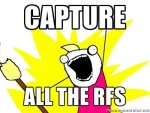tim292stro
Well-known member
- 2,117
- 40
- 48
- Location
- S.F. Bay Area/California
For HAM RX/TX, there are licensing requirements I have to abide by, so I'll be using the FlexRadio SDR line for simplicity - this is a half-depth 2U transceiver that can be remoted over TCP/IP networks (simple plug in for Asterisk). For the other bands, and for general listening and snooping, there are many COTS options available - the now famous RTL2832 SDR receivers, HackRF, BladeRF, etc... The problem is that most of these solutions are typically limited to one RX antenna, and I want to do broadband radio direction finding and filtering, in addition to non-transmission RADAR using RF energy in the free space (from other transmitters). This means I need high speed time-aligned RF inputs - like a 4-channel RF Oscilloscope that I can post-process on. What I want to be able to do is capture all the RFsWhat SDR gear to you plan on using?...

and be able to decode any signal of interest on the fly to know what is broadcasting in the receivable RF space, which direction it's coming from, and listen to and decode the signals which are legal to listen to. I'm attempting to design my receiver to cover two sets of broadband antennas that cover 5kHz-30MHz and 30MHz-6GHz, four antennas in each set (8 total).
I have had success - with short experiments, I've connected two Uniden PRO520XL's (no internal modifications) to RoIP102's and then to RaspberryPi's. I placed one at my parent's and one and my apartment and was able to broadcast across town both ways, change channels on the radios, and use a handheld CB to broadcast into the PBX. The hardest part was modifying the Asterisk conference bridge to support single party talking and the un-mute interlocking - the radio's VoIP bridge (raspberry Pi A+) calls into the PBX as a conference leader which gives it special audio privileges, everyone else dials in as a user. I'll probably submit that code into Asterisk later so it becomes part of Asterisk's permanent capabilities....I've been following your posts on your various project and especially like the idea of connecting the radios into the VoIP system. Have you actually done this yet? How well does it work in practice? I mostly wonder about the TX/RX switching issues on the radio side of the equation.
Basically the Raspberry Pi A+ board is running Raspbian (Debian Linux for Raspberry Pi), and a lightly modified LinPhone client. Raspberry Pi has Ethernet, audio, and GPIOs that can be programmed, so if you unplug the microphone from the radio and build an adapter that converts the speaker out and microphone in and key-switch to line audio (to the radio's mic) and mic audio (from the radio's speaker) and a GPIO, you can do two radios per Raspberry Pi (1/5th the cost of RoIP102, double the capability). To control channels on the CB radios, I use photodiodes to literally read the dual 7-segment displays, and a motor on a gear box to turn the knob. Remember FCC regs require that you not modify the radio for it to be legal in the CB band - and I was in direct control of both radios at all times which is required for a radio relay.

